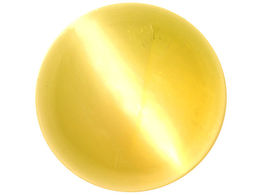|
More Gemstone Families Beryl Gemstone Family Chalcedony Gemstone Family Corundum Gemstone Family Zoisite Gemstone Family Feldspar Gemstone Family Spodumene Gemstone Family Read about More Beautiful Gemstones Agate Amber Diamond Emerald Fluorite Garnet Iolite Ivory Jade Jasper Jet Azurite Apatite Aquamarine Calcite Labradorite Malachite Moonstone Morganite |
 cymophane
cymophane
Chrysoberyl cat’s-eye: Chrysoberyl cat’s-eye was first noted in 1910. This gemstone also called cymophane which is Greek for “waving light” referring to the optical effect cause by rutile needle inclusions. These parallel inclusions produce a silver-white line which appears as moving light ray in a cabochon-cut gemstone (this cat’s-eye effect moves side to side when the gemstone is rotated). The gemstone’s color change from honey yellow and honey brown to yellowish green and nearly bright green. The yellow color is due to presence of small amounts of iron in the composition of the gemstone. The most attractive color for the gemstone is a light golden brown with a darker shadow that produces the gemstone’s “milk and honey” or cat’s-eye effect. Sri Lanka, Brazil, and China are the main source for Chrysoberyl cat’s-eye. At the end it is worth noting that Chrysoberyl cat’s-eye can easily be confused with quartz cat’s-eye.
References:
1- Judith Crowe, The Jeweler's directory of gemstones, Firefly books, 2012
2- Walter Schumann, Gemstones of the world,Sterling Publishing Co. Inc, New York.
3- Lance Grande and Allison Augustyn, Gems and Gemstones timeless natural beauty of the mineral world, The University of Chicago Press.
4- Michael O'Donoghue, Gemstones, Cambridge University Press.
1- Judith Crowe, The Jeweler's directory of gemstones, Firefly books, 2012
2- Walter Schumann, Gemstones of the world,Sterling Publishing Co. Inc, New York.
3- Lance Grande and Allison Augustyn, Gems and Gemstones timeless natural beauty of the mineral world, The University of Chicago Press.
4- Michael O'Donoghue, Gemstones, Cambridge University Press.
